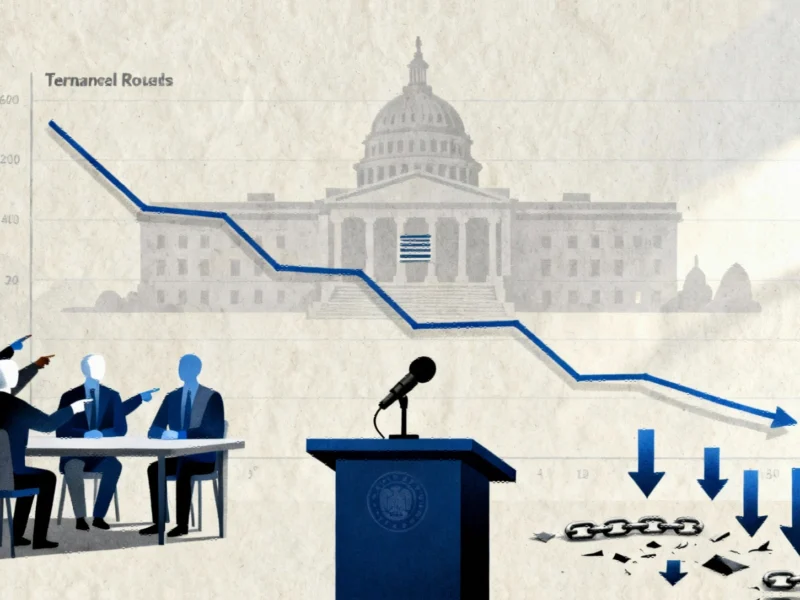TITLE: Financial Markets Grapple With Data Void as Political Stalemate Drags On
U.S. Treasury yields edged lower on Friday as the federal government shutdown entered its 17th consecutive day, leaving investors navigating increasingly murky waters without crucial economic indicators. With lawmakers showing little progress in budget negotiations, financial markets are navigating unprecedented uncertainty as the stalemate enters its third week, creating challenges for institutions and manufacturers alike who rely on timely economic data for strategic planning.
The prolonged shutdown has effectively silenced key government statistical agencies, depriving markets of employment figures, inflation data, and manufacturing reports that typically guide investment decisions. This information vacuum comes at a particularly sensitive time as manufacturing sectors increasingly depend on real-time economic intelligence to optimize production schedules and inventory management. One basis point equals 0.01%, and the inverse relationship between yields and prices has become particularly pronounced during this period of limited information flow.
With traditional data sources unavailable, market participants have turned to alternative indicators, including close monitoring of Federal Reserve officials’ speeches. Federal Reserve Bank of St. Louis President Alberto Musalem’s scheduled address later today is being particularly anticipated for any insights into how central bankers are assessing economic conditions amid the statistical blackout. The situation highlights how modern financial systems struggle to function efficiently without reliable government data, potentially affecting everything from supply chain financing to capital expenditure decisions.
Private Credit Market Jitters Add to Concerns
Meanwhile, separate troubles are emerging in credit markets as recent bankruptcies in auto-related sectors and troubling bank disclosures have raised questions about lending standards. Wednesday evening brought news that Zions Bancorporation had absorbed a $50 million loss on two commercial loans, followed by Western Alliance’s Thursday disclosure alleging borrower fraud.
These developments have amplified concerns about potential weaknesses in credit markets that could have ripple effects across industrial sectors. The situation echoes challenges seen in other technology-driven fields where human analytical capabilities continue proving essential for identifying subtle risk patterns that automated systems might miss.
Broader Economic Implications for Industrial Sector
The combination of political gridlock and credit concerns creates a particularly challenging environment for industrial companies making long-term investment decisions. Major manufacturing initiatives often require stable financing conditions and predictable economic policy, both of which are currently in question.
This uncertainty is reflected in parallel challenges facing other capital-intensive projects, including renewable energy developments where local planning decisions can significantly impact project timelines and financing viability. Similarly, the current environment may affect how companies approach technological transformation, particularly as artificial intelligence investments face increased scrutiny amid broader market volatility.
Energy and Resource Projects Face Headwinds
The financial market uncertainty coincides with challenges in energy and resource development that could have long-term implications for industrial costs and supply chain stability. Recent developments in the United Kingdom demonstrate how local policy decisions can create energy security concerns that ultimately affect manufacturing competitiveness through higher energy costs.
Similarly, strategic materials projects face obstacles, as evidenced by the recent abandonment of a UK rare earth refinery initiative that would have supported high-tech manufacturing. Such developments highlight how financial market conditions can influence critical supply chain investments, potentially leaving manufacturers vulnerable to material shortages or price spikes.
Market Participants Adjust to New Reality
As CNBC’s Jim Cramer noted Thursday, “Today got real ugly, but at least we finally have something that can make the Federal Reserve itchy to cut interest rates sooner rather than later: bank loans gone bad. Nothing motivates the Fed to move faster than credit losses, because they’re a definitive sign that the economy is going south.”
This sentiment captures the delicate balance markets are attempting to strike—weighing the negative implications of credit deterioration against the potential for more accommodative monetary policy. For industrial companies, this translates into increased difficulty forecasting input costs, financing expenses, and customer demand at a time when global supply chains already face multiple pressures.
The coming days will prove critical as markets watch for any signs of political resolution while monitoring credit conditions and Federal Reserve communications for clues about the central bank’s assessment of evolving risks. Until the data spigot turns back on, however, investors and corporate planners alike will continue operating with limited visibility into the true state of the U.S. economy.
Based on reporting by {‘uri’: ‘cnbc.com’, ‘dataType’: ‘news’, ‘title’: ‘CNBC’, ‘description’: ‘CNBC International is the world leader for news on business, technology, China, trade, oil prices, the Middle East and markets.’, ‘location’: {‘type’: ‘place’, ‘geoNamesId’: ‘5101760’, ‘label’: {‘eng’: ‘New Jersey’}, ‘population’: 8751436, ‘lat’: 40.16706, ‘long’: -74.49987, ‘country’: {‘type’: ‘country’, ‘geoNamesId’: ‘6252001’, ‘label’: {‘eng’: ‘United States’}, ‘population’: 310232863, ‘lat’: 39.76, ‘long’: -98.5, ‘area’: 9629091, ‘continent’: ‘Noth America’}}, ‘locationValidated’: False, ‘ranking’: {‘importanceRank’: 14205, ‘alexaGlobalRank’: 270, ‘alexaCountryRank’: 92}}. This article aggregates information from publicly available sources. All trademarks and copyrights belong to their respective owners.



